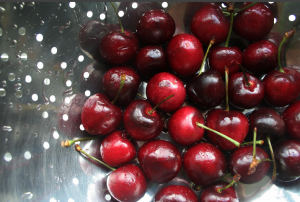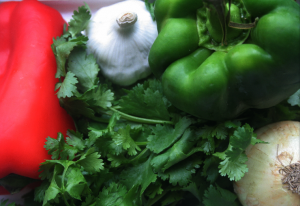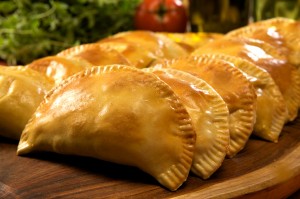Author Archives: Karina
Turtle Stew and Chicharrón
At first glance, you may think this pairing comes straight out of Bizarre Foods. However, at Luz Restaurant in the Cayman Islands, these two dishes are bestsellers on the menu. Staples of the Caymanian and Honduran kitchens come together in this casual Georgetown eatery which serves traditional Caymanian fare like turtle stew and stewed conch and a list of Honduran delicacies like garnaches (corn tortillas topped with cheese, cabbage and beans), chicharrón con yuca(fried pork rinds with yucca), and carne asada (roast beef). On my last trip to this sunny sanctuary, I learned about the important Honduran presence in the Caymans and that people from the Bay Islands of Honduras have been crossing the Caribbean Sea and settling in the Cayman Islands for years.
It started in the 40’s and 50’s, when local Caymanians traveled to the English-speaking Bay Islands by catboats for food and resources limited by the arid local soil. Located about 145 nautical miles away, they were easily accessible. The Bay Islands’ history includes many disputes between Spain and England during colonial times, so much so that English is mostly spoken here despite the fact that Spanish is the official language of Honduras.
To Caymanians, Spanish is synonimous with people from Honduras. It’s incredible to think how Latin America is alive in the most unexpected of places.
Watercress Salad Video
Hi friends!
I’m excited to share with you the first Latinfoodie Video Blog. Go ahead and tell me what you think, and look out for our next webisode. We’ll continue to feature delicious recipes from kitchens all over Latin America.
¡Buen provecho!
Sip Your Cherries

Rainier cherries for the cooler
It’s been a wet summer. The sun came out today first time this week. I packed a tote and ran to the park, trying to beat the rain. Now I lay here and feel it on my arms, along with ripened mulberries that fall around me like confetti. Above me a squirrel feasts away. On days like these, I crave something sunny and bright to lift me up and take me back to the sticky summers in the Dominican Republic, playing outside the whole day and cooling off with a vigorous dip in the neighborhood pool. It also reminds me of fruit from home: guanábana –soursop– green and spiky with white creamy flesh, mangoes from Baní bright and sweet as candy, cherries, tiny tart and tangy that we used to blend into juice. Inspired by care-free days and Mexican Aguas Frescas(refreshing drinks of fruit and water), I’ve taken plump Rainier cherries bursting with antioxidants and vitamin C, and prepared something that cools you off and lifts you up, perfect for those rainy summer days.
Cherry Cooler
Ingredients:
- 1 cup of cherries (your favorite kind will do)
- 2 cups of drinking water
- 1 tablespoon sugar
- ice
Preparation:
Pit cherries(I smash them with the side of a knife and pull the pits out). Blend with water and sugar. Pass through strainer to remove skin. Pour over a glass full of ice. Cheers!
So you think you can Cuban?
I don’t know what it is about the media these days that has me finding inspiration in the most random of places. This week I began watching one of my favorite shows of all time: So you think you dance? Alright alright, I’m a total fan. There, I said it.
In search for something to eat that would get my taste buds moving, I decided to visit Margon Restaurant, a tiny, loud Cuban eatery located in Midtown, on 46th street and 6th Avenue. Undettered by the unassuming entrance, I went inside and found myself in what at first seemed like a comfort food haven. On the left side of this small space was a cornucopia of trays brimming with beef stew, roasted chicken, red beans, yellow and white rice, plantains, octopus and avocado salads, and other Cuban classics.
The place was buzzing with regulars, young preppy employees from nearby offices, tough-looking construction workers seeking to refuel on their break, and a couple of adventurous tourists finishing their coffee and flans while studying maps of the city. The place was definitely alive and vibrant with energy, people in line, ordering, eating, waiting for empty seats, talking and laughing. This place is a far cry from a restaurant, it’s more like a cafeteria, but is somewhere you can easily become a regular, offering simple, hearty home-cooked Latin fare.
Although the food seemed every bit authentic at first, transporting me to some forgotten spot in Miami’s Little Havana, the overall experience left me disappointed. I ordered the roasted chicken, white rice, red beans and maduros(sweet ripe plantains). The food was served not in a plate, but in an aluminum container. Had they run out of plates?
The rice was fresh and red beans creamy and delicious, but the roasted chicken was swimming in an oily mess and the avocado was overly mushy and past its prime. Everybody else around me didn’t seem to mind, however. It is a place where you don’t have to worry about being too loud, where you can easily disappear into the crowd.
I had read about Margon on www.midtownlunch.com, a blog that deemed it a culinary institution, raving about its Cuban sandwich and fruit shakes. I didn’t get the chance to taste either of these and perhaps I’ll have to if I ever go back. In the meantime, I’ll stick to giving my palate a whirl with my own versions of Cuban at home.
Puerto Rican Soul

Some of the ingredients for the sofrito
To celebrate the Latin American spirit on Capitol Hill, infuse your dishes with a Caribbean kick. Try sofrito, the secret to the aromatic, flavorful cuisine from Puerto Rico. Sofrito resembles the holy trinity of Italian cuisine(onion, carrot, celery) in that it is the beginning of many dishes, but adds cilantro and culantro, herbs evocative of Latin America kitchens. Sofrito, also known as recaíto, is the essence of Puerto Rican cuisine: from stews to rice to casseroles, it imparts the complex flavors that characterizes much of this Caribbean fare–warm, aromatic, pungent and fruity.
In search of an authentic sofrito recipe, I made my way up to La Fonda Boricua, a Puerto Rican institution located in the heart of El Barrio in East Harlem. Here I ordered a dish of stewed goat (chivo guisado) and rice with pigeon peas(arroz con güandules) with an avocado salad. The meat, to my dismay, was tough and excessively gamey, but its sauce was vibrant and perfumed with herbs and peppers, rounding out the nuttiness of the rice with its sweetness.
Jorge Ayala, chef of La Fonda has shared his recipe of sofrito. Use it as a marinade for your favorite chicken or rice dishes, or any time you want to vary the flavors of your homemade meal.
Sofrito(from Jorge Ayala of La Fonda Boricua)
1 cup chopped white onion
1 cup chopped green pepper
1 cup chopped red pepper
4 garlic cloves
1/4 cup cilantro leaves
1/4 cup culantro leaves
Blend all ingredients and add to ice tray. Freeze and use one cube per dish.
Artisanal Empanadas

Empanadas galore at the Emporium
Light in Miami
A few days in Miami fill me with delight. I look out the window and what do I see? Everything alive with color, the sky and the sea two jewels of blue, refreshing and soothing. The palms, with green and yellow fingers waving in the breeze, and hot pink bougainvillea bursting with their fruity shade. So many memories this city holds. Today, it hosts yet another afternoon to treasure far into the future.
At the Eden Roc Hotel and Spa in Miami Beach, I sit on their boardwalk cafe and see the people breezing by, heads bobbing arms swinging, and on the sand in the distance, enormous umbrellas mingle with tanned happy bodies. It’s a brilliant Sunday afternoon and everyone is at the beach, including Mom and us kids. I order a burger and frozen mojito to kick start the celebration. It’s icy and minty and rushes to my head after the first few sips, making me giggly and my shoulders lose. I dig into the burger; it’s juicy and hot off the grill, and sits on a bun that’s soft and chewy, the ideal ratio of bread to beef. In the meantime, the fries are thin and delicate, and beautifully golden.
These are the moments that are worth remembering. When life, in its simplicity, opens itself up and we must take it all in, every taste, every sight, every fragment of the conversation which is full of light, like the day, even the man in a hawaiian shirt who sings Bob Marley out of tune.
Mestizo cuisine
Dunia and Espartaco Borga have one mission: to bring a “mestizo” experience to the table. Mestizo, a Spanish word which describes a mixture of European, African and American Indian races comprise much of the population of Latin America. For the past 8 years, Colombian-Yugoslavian Dunia Borga and Mexican-Venezuelan Espartaco Borga have joined forces in life and in the kitchen to make dishes that exemplify their mixed heritage. From their Cuban-styled chicken with sour orange mojo prepared with champagne to their own version of Mexican chilaquiles with gruyere cheese, this husband and wife team invaded Dallas with delicious traditional Latin American fare that preserves the integrity of classical dishes, yet is continuously refreshed with European elements.
In their restaurants, they have shied away from the Nuevo Latino wave of the 1990’s that sometimes got overly experimental with typical Latin ingredients like mango and plantains. Here, they have applied their philosophy, respecting traditional Latin flavors like the achiote-spiked shredded beef they use in their rendition of Venezuelan pabellón criollo and creating an environment that’s warm, cozy and familiar.
At their table, as in all of Latin America, family is the foundation of life. “We don’t just consider family our blood relatives, but anyone who sits at our table and shares our meal. Whether waiter, neighbor, friend or stranger, during those precious moments, they all become family.”
We meet again

Watercress and warm potato salad
At home, we call it berro. I remember my Mom snacking on it happily, trying to convince me to try it by raving about how nutritious it was. I would nibble on a stem and spit it out, my 10-year old palate tortured by its bitter bite.
Fast forward 20 years and inspired by this memory of youth, I find myself ordering it at Libertador, an Argentinian parrillada restaurant in the neighborhood that opened its doors a few weeks ago, bravely emerging in the midst of it all. It is a warm airy space with an open kitchen where the chef skillfully grills classic cuts of Argentinian beef like lomo, entraña and bife.
During my visit, before indulging in a tender yet beautifully charred skirt steak, I dug into a watercress salad dressed with garlic. The sweetness of the garlic was a successful balance to the pungency of the green; however, its quantity weighed down the leaves, turning the dish into an edible guard against vampires.
Coming home a bit discouraged but bitten by the watercress bug, I rummaged through my cookbooks and found a delicious way to incorporate this ingredient into a simple dish that takes me back, yet settles me into the present with its refreshing yet comforting flavors.
Watercress and warm potato salad (adapted from Martha Stewart Living Cookbook)
12 small creamer potatoes scrubbed
3 tablespoons olive oil
salt
pepper
sugar
1/2 lemon with zest grated
1 teaspoon red wine vinegar
2 teaspoons lemon juice
1 bunch watercress with hard parts trimmed off
Season potatoes with olive oil, salt and pepper and roast until golden at 375C(about 45 min.) In a bowl, combine lemon juice, zest, olive oil, vinegar, sprinkles of salt and sugar. Let rest until potatoes are done. Add potatoes to watercress and season with dressing.
Tiny plates, big punch
Tapas, shrunken Spanish dishes traditionally served as appetizers or as a light meal, have sprouted up all over the press. Two new tapas-styled restaurants in NYC, La Fonda del Sol and Txiquito were reviewed in the New York Times this week, with the former getting a two-starred “very good” rating from Bruni.
They then reappeared in Saveur magazine, as Los Perretes’ dainty tins packed with octopus and baby sardines from Galicia, meant to be served simply with wine or crackers. Latin America has also jumped on the tapas bandwagon. Macondo in the Lower East Side of Manhattan serves what it calls comida de la calle (Latin street food) which include piping hot bacalaitos or stuffed codfish fritters decorated with a sweet and spicy guindilla sauce. There are also the creamy yucca fries topped with garlicky chimichurri. How the chef is able to get these so velvety inside and perfectly crisp outside is beyond me–they are a perfect foil, hot in every bite, to one of its clever cocktails concocted with guava and whisky, tamarind and tequila or peach and pisco.
In Dallas, Texas at Aló, another small Latin American restaurant specializing on contemporary street foods of Mexico and Peru, draws an emphasis on ceviche and tiraditos. Its food menu includes BITES (SIPS and DULCE), and offers thinly sliced yellowtail and tuna which you can dip in Peruvian sauces as well as cold potato causas layered with smoked salmon, grilled shrimp or arepa crusted calamari.
Are Latin American tapas the next evolution of latin food? Is downsizing stretching into the culinary world in the way of small dishes? I wouldn’t be surprised if in the coming months, we see more Latin American tapas, a fresh addition to traditional latin cuisine.

Food For Thought